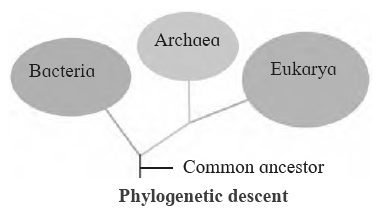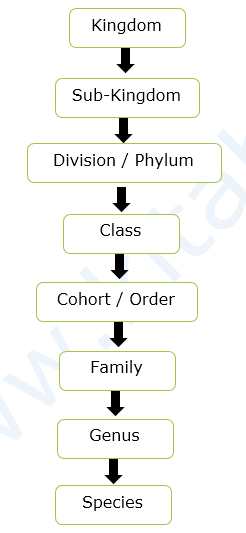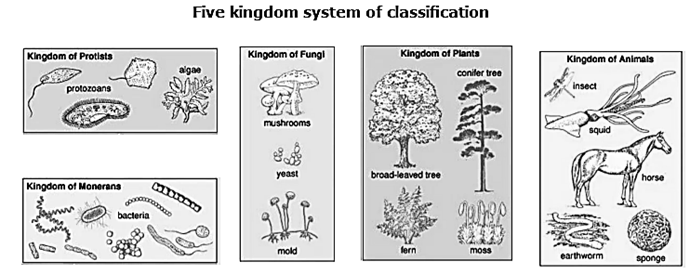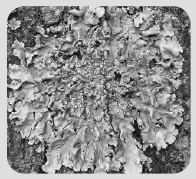Systematics of Living Organisms
Class-11th-Science-Biology-Chapter-2
Notes
|
Topics to be Learn :
|
Definition of systematics given by G. Simpson in 1961 : Systematics is the study of kinds and diversity of organisms and their comparative and evolutionary relationship.
- Systematics considers evolutionary relationships between organisms.
- The word systematics is derived from the Latin word ‘Systema’. It means the systematic arrangement
Taxonomy : Taxonomy means classification following certain rules or principles.
- Taxonomy is a branch of biology which deals with the nomenclature, collection, identification, description and classification of plants, animals and micro-organisms.
- The term taxonomy was first introduced by A. P. de Candolle (Swiss Botanist) [1778-1841].
Uses of taxonomy are as follows:
Classification : Classification is the arrangement of organisms or groups of organisms in distinct categories in accordance with a particular and well-established plan.
It is based on the similarities and differences among the organisms.
There are three types of classification systems : Artificial system: Natural system: Phylogenetic system:
The visible characters of organisms include habit, colour, form, mode of respiration, growth, reproduction, etc.
Three Domains of Life :
Evolution : Adaptation of an organism to its environment is known as evolution.
- It is believed that the life originated on earth in its very simple form.
- Constant struggle of the early living beings gave rise to more and more perfect forms of life
- This struggle and progress are evolution which led to formation of diverse life forms.
- It changes the characteristics of a species over several generations and relies on the process of natural selection.
- Evolution involves the changes in flora and fauna of the earth.
- The process of evolution is slow and long..
Three Domains of Life : Carl Woese in 1990 proposed three domains of life to classify life forms. They are Archaea, Bacteria and Eukarya. Domain is an unit larger than Kingdom in the system of classification
- Both archaea and bacteria have prokaryotic cells. They differ in their cell wall structures.
- Domain Eukarya has eukaryotic cells.
Chemotaxonomy : It is a method of biological classification based on the similarities and differences in structure of certain chemical compounds present among the organisms being classified.
Numerical taxonomy: It is based on quantification of characters and develops an algorithm for classification. After comparison the organisms are grouped according to overall similarities or dissimilarity.
Cladogram : It is a representation of hypothetical relationship denoting a comparison of organisms and their common ancestors. It has a typical branching pattern.
Diagrammatic representation of three domains of life with the help of cladogram as shown in fig.

Phylogeny:
- It is the evolutionary relationship of organism
- It is an important tool in classification as it considers not merely the morphological status but also the relationship of one group of organisms with other groups of life.
- The system helps to understand the evolution and also focuses on the similarities of their metabolic functioning.
- Woese’s three domain concept as well as Whittaker’s five kingdom system are examples of phylogenetic relationship.
DNA barcoding : DNA barcoding is a new method for identification of any species based on its DNA Sequence which is obtained from a tiny tissue sample of the organism under study.
Use of DNA barcoding :
- DNA barcoding helps to study newly identified species.
- Understanding ecological and evolutionary relationships between living organisms.
Process of DNA barcoding :
The process of DNA barcoding includes two basic steps:
- Collecting DNA barcode data of known species.
- Matching the barcode sequence of the unknown sample against the barcode library for identification.
Applications of DNA barcoding : The applications of DNA barcoding are as follows:
| DNA Barcoding:
It is a recent development in genetics, in which a short DNA sequence is read from genetic sample obtained from the organism. This sequence is recorded in a public database such as Genbank. This sample is then compared against all other samples present in the genbank to know how closely related two organisms are. In a case study, it was used to demonstrate that the common butterfly from Central America was in fact a group of closely related species with very related morphological characters living within the same regions. This discovery exposed a hidden wealth of biodiversity. |
Recent approaches in taxonomy : Morphological Approach: It deals with the identification of an organism on the basis of its morphological features which are observed by naked eye or with the help of microscope. Embryological Approach: Embryonic stages an organism helps greatly in identification. It is used in those cases whose morphological approach in less reliable. Ecological Approach: It is based on the various habits of an organism. Behavioral Approach / Ethological Approach: It is extremely useful in identification of closely related species. Organisms are identified on the basis of their ethological characters. These characters are genetically determined. e.g. Sound production, bioluminescence, etc. Genetical Approach / Cytological Approach: Identification of organisms at a cellular level. It includes structural, genetical and biochemical aspects. In this DNA hybridization and karyological studies are used. Biochemical Approach: Organisms are identified on the basis of biochemical composition. In this, Chromatography, electrophoresis and immunology techniques are used. Numerical Taxonomy: In this method the data is numerically evaluated in the computer and similarities / differences between organisms is obtained with relative ease. After comparison the organisms are grouped according to overall similarities or dissimilarity.
Taxonomic categories :
- Taxonomic Category is a rank or level in the hierarchical classification of organisms.
- Each category is referred to as a unit of classification.
- Category is a part of taxonomic arrangements hence, called taxonomic category.
- All categories together constitute the taxonomic hierarchy.
Compulsory categories : Kingdom, division, class, order, family, genus, species are the compulsory categories.
Facultative taxonomic categories : Sub-order, sub-family, etc. are the facultative categories which are used when required
Taxonomic hierarchy :
The manner of scientific grouping of different taxonomic categories in a descending order on the basis of their ranks or positions in classification is called taxonomic hierarchy.
Taxon :. Taxon is a group of living organisms of any rank in the system of classification.
Examples- In plant kingdom, each taxonomic group such as angiosperms, dicotyledonae, polypetalae, malvaceae represents a taxon.
Flow Chart of Taxonomic hierarchy :

Units of Classification : Species : Genus : Family : Cohort/Order : Class : Division/ Phylum: Sub-kingdom : Kingdom :
Classification of China-rose and Cobra :
Category
Taxon-China-rose
Taxon-Cobra
Kingdom
Plantae
Animalia
Division/Phylum
Angiospermae
Chordata
Class
Dicotyledonae
Reptilia
Sub-class
Polypetalae
Diapsida
Series
Thalamiflorae
Order
Malvales
Squamata
Family
Malvaceae
Elapidae
Genus
Hibiscus
Naja
Species
rosa-sinensis
Naja
Organisms with their Taxonomic Categories :
Common Name
Man
Housefly
Mango
Wheat
Biological Name
Homo sapiens
Musca domestica
Mangifera indica
Triticum aestivum
Genus
Homo
Musca
Mangifera
Triticum
Family
Hominidae
Muscidae
Anacardiaceae
Poaceae
Order
Primata
Diptera
Sapindales
Poales
Class
Mammalia
Insecta
Dicotyledonae
Monocotyledonae
Phylum / Division
Chordata
Arthropoda
Angiospermae
Angiospermae
Q. Why horse and ass are considered to be two different species or animals?
Ans. Species is a group of organisms that can interbreed under natural conditions to produce fertile offsprings. Horse and ass (donkey) are considered to be two different species or animals, because; they cannot interbreed under natural condition to produce fertile offspring.
Nomenclature : The art of giving name to the organism is called nomenclature.
Vernacular name : Vernacular names are the names which are given to organisms in a particular region and language by local people.
Disadvantages of vernacular names/ local names/ common names:
Binomial system of nomenclature : A system of nomenclature of plants and animals in which the scientific name consists of two words or parts or epithets is called binomial nomenclature.
This system of nomenclature was developed by Carl Linnaeus. He gave certain principles for this nomenclature in his book ‘Species Plantarum’.
Rules of binomial nomenclature:
Importance of Binomial nomenclature :
Five Kingdom system :
Two kingdom system was introduced by Carl Linnaeus. In which all plants and animals were classified into kingdom plantae and kingdom animalia respectively
Drawback of two kingdom system of classification :
- Two kingdom system was found inadequate for classification of some organisms like bacteria, fungi, Euglena, etc.
- Two kingdom system of classification did not distinguish between unicellular and multicellular organisms, eukaryotes and prokaryotes, photosynthetic and non-photosynthetic organisms.
Five kingdom system of classification : Five kingdom system of classification was proposed by R.H. Whittaker. This system shows the phylogenetic relationship between the organisms.
The five kingdoms are:
- Kingdom Monera
- Kingdom Protista
- Kingdom Plantae
- Kingdom Fungi
- Kingdom Animalia
The criteria used by Whittaker for his system were:

Kingdom Monera :
Salient features of Kingdom Monera:
- Size: The organisms included in this kingdom are microscopic, unicellular and prokaryotic.
- Occurrence: These are omnipresent. They are found in all types of environment which are not generally inhabited by other living beings.
- Nucleus: These organisms do not have well defined nucleus. DNA exists as a simple double stranded circular single chromosome called as nucleoid. Apart from the nucleoid they often show presence of extra chromosomal DNA which is small circular called plasmids.
- Cell wall: Cell wall is made up of peptidoglycan (also called murein) which is a polymer of sugars and amino acids.
- Membrane bound cell organelles: Membrane bound cell organelles like mitochondria, chloroplast, endoplasmic reticulum are absent. Ribosomes are present, which are smaller in size (70S) than in eukaryotic cells.
- Nutrition: Majority are heterotrophic, parasitic or saprophytic in nutrition. Few are autotrophic that can be either photoautotrophs or chemoautotrophs.
- Reproduction: The mode of reproduction is asexual or with the help of binary fission or budding. Very rarely, sexual reproduction occurs by conjugation method.
Examples: Archaebacteria: e.g. Methanobacillus, Thiobacillus, etc. Eubacteria: e. g. Chlorobium, Chromatium, Cyanobacteria e.g. Nostoc, Azotobacter, etc.
Morphologicaly, bacteria are categorised into four groups,
- spherical-Coccus,
- Rod-shaped bacillus,
- Comma or kidney shaped- vibrio
- Spiral- spirillum.

Locomotion in members of kingdom Monera : The organisms may be either motile or non-motile. If motile, the locomotion is due to flagella or due to gliding movements.
On the basis of evolution, bacteria can be classified as Archaebacteria and Eubacteria. Archaebacteria: Eubacteria:
Useful bacteria: Most of the bacteria act as a decomposer. They breakdown large molecules in simple molecules or minerals. Examples of some useful bacteria:
Harmful bacteria: This includes disease causing bacteria. They cause various diseases like typhoid, cholera, tuberculosis, tetanus, etc. Examples of some harmful bacteria: Mycoplasma : These are the smallest living cells known.
Kingdom Protista : Unicellular eukaryotic organisms are included in kingdom Protista. Kingdom Protista shows link with all eukaryotic kingdoms such as kingdom plantae, fungi and Animalia.
Different types of Protists : Protists are of different types: Plant like protista (Photosynthetic protists): Animal like protists (Consumer protists): Dinoflagellates: Fungi like protists (Consumer decomposer protists): Euglenoids:
Q. Why diatoms are used in filtration and polishing?
Diatoms forms a substance called Diatomaceous earth. These are the shells of diatoms containing silica that left behind for many years. Diatomaceous earth is granular, hence it is used in polishing and filtration.
Kingdom plantae :
Characteristics of Kingdom plantae:
- Kingdom plantae is dominated by autotrophs.
- It also includes some semiautotrophic members, the insectivorous plants like Venus fly trap, pitcher plant, bladderwort, as well as heterotrophic parasitic members like Cuscuta.
- Members of this kingdom are eukaryotic, multicellular, having eukaryotic cells containing chlorophyll.
- Their cell wall is mostly made up of cellulose. ‘
- They exhibit alternation of generation i.e. life cycle has two distinct phases.
- It is divided into two major groups Cryptogams and Phanerogams.
Kingdom Fungi :
General characters of Kingdom Fungi: _
- Type of organisms: It is a unique kingdom of eukaryotic heterotrophic organisms, showing extracellular digestion. They may be unicellular or multicellular and filamentous. These are commonly found in warm and humid places.
- Nucleus: The cells may be multinucleate or uninucleate. '
- Body: Multicellular organisms consist of a body called mycelium in which a number of thread or fibre-like structures called hyphae are present. The hyphae may be with septa (septate) or without septa (aseptate). The non-septate multinucleated hyphae are called coenocytic hyphae.
- Cell wall: The cell wall in fungi is composed of chitin or fungal cellulose.
- Cell organelles: The fungi contain well organized membrane bound cell organelles except the chloroplasts.
- Nutrition: In fungi, chloroplast is absent, thus they cannot synthesize their own food by photosynthesis. Due to this, fungi exhibit heterotrophic mode of nutrition, and most of the members are saprophytes and absorb food which is decomposed (digested) outside. Some are parasitic or predators.
- Reproduction: They reproduce both sexually as well as asexually. Asexual reproduction takes place by fragmentation, fission and budding.
- Some fungi are symbiotic. These fungi either live with algae as lichens or as mycorrhiza in association with roots of higher plants.
Fungi are further classified into four types on the basis of their structure, mode of spore formation and fruiting bodies as follows: Phycomycetes: Ascomycetes: Basidiomycetes : Deuteromycetes:
Reproduction in fungi : Germination produce mycelium
Reproduction
Asexual reproduction
Sexual reproduction
Phycomycetes
Motile zoospores, non-motile aplanospores produced endogenously in sporangium
Zygospore formation occurs due to isogamy (similar gametes fuse) or anisogamy (dissimilar gametes fuse) or oogamy (small flagellated male gamete and non-flagellated large female gamete fuse)
Ascomycetes
Conidia produced exogenously on conidiophores.Conidia on
Ascospores are produced in sac like asci (sing. ascus) endogenously. Asci are arranged in fruiting, bodies called ascocarps.
Basidiomycetes
Generally, not Found.
Plasmogamy occurs -> fusion of two vegetative cells —> give rise to basidium —> karyogamy and meiosis occurs in basidium to produce four basidiospores.
Deuteromycetes
Conidia
Either absent or not known
Economic importance of fungi in various sectors : Role of fungi in medicine: Role of fungi in industries: Role of fungi in food: Role of fungi as biocontrol agents:
Q. How the fungi are different from plants?
Fungi are different from plants because:
Diseases in plants : There are different pathogens like fungi, bacteria, viruses that cause diseases in plants. The common plant diseases are:
Kingdom Animalia :
General characters of Kingdom Animalia: .
- Types of organisms: The organisms are multicellular and eukaryotic.
- Habitat: The organisms may be aquatic, terrestrial, amphibious or aerial in habitat.
- Cell organelles: The organisms do not possess cell wall, plastids and central vacuole.
- Locomotion: Majority of the animals are motile. However, few like sponges are sedentary.
- Sense organs: They possess sense organs, nervous system and respond to stimuli by exhibiting certain behaviour.
- Reproduction: They mostly reproduce sexually by producing gametes, while some can reproduce asexually.
- Nutrition: They are heterotrophic, mostly holozoic, and sometimes parasitic.
- Growth: It is determinate. (Follow definite pattern).
Differentiate between Plantae and Animalia : 2-They do not show locomotion. 3-Cell wall is present. 4-Chloroplast present. 5-They do not possess nervous system. 6-Reproduction can be both sexual and asexual. 2-They show locomotion. 3-Cell wall is absent. 4-Chloroplast absent. 5-They possess well developed nervous system. 6-Mainly shows sexual reproduction.
Plantae
Animalia
1-Autotrophic mode of nutrition.
1-Heterotrophic mode of nutrition.
Acellular organisms :
Viruses : These obligate parasites were given the name 'virus' by M. J. Beijernek, after observation that they were able to migrate in an agar gel. Thus, being and infectious soluble agent, he called the filtrate as 'contagium vivum fluidum' (infectious living fluid)
Stanley demonstrated that viruses are inert and can be crystallised.
Characteristics of Viruses :
Structure of virus:
Types of viruses : Depending upon the host, viruses are classified into three types as: Plant virus: Animal virus: Bacteriophage:
Diseases caused by viruses in plants & animals:
- Diseases in plants: Leaf curling, yellowing, mosaic formation, etc.
- Diseases in animals: Swine flu, Small pox, mumps, herpes, common cold, AlDS, etc.
Viroids:
- These are mainly plant pathogens.
- Viroids were discovered by Theodor Diener.
- The first viroid discovered was PSTV (Potato spindle tuber viroid) which causes a disease in potato
- Viroids are very small, circular, single stranded RNA which are without any protein coat.
- Viroids are smaller in size than viruses.
Differentiate between viruses and viroids : 2-They are larger in size. 3-They can infect plant, animals and bacteria. 4-The genetic material can be ss-RNA, ds-RNA or DNA. 5-Protein coatis present, 2-They mainly infect plants. 3-The genetic material is single stranded circular RNA 5-Protein coat is absent.
Viruses
Viroids
1-They have high molecular weight.
1-They have low molecular weight.
Lichens :

Click on below link to Download PDF from store
MSBSHSE-Class-11th-Science-Biology-Chapter-2-Systematics of Living Organisms-Notes
MSBSHSE-Class-11th-Science-Biology-Chapter-2-Systematics of Living Organisms-Solutions
MSBSHSE-Class-11th-Science-Biology-Chapter-2-Systematics of Living Organisms- Text Book
Useful links :
| Main Page : - Maharashtra Board Class 11-Science-Biology - All chapters notes, solutions, videos, test, pdf.
Previous Chapter : Chapter 1 -Living World - Online Notes Next Chapter : Chapter 3 -Kingdom Plantae - Online Notes |